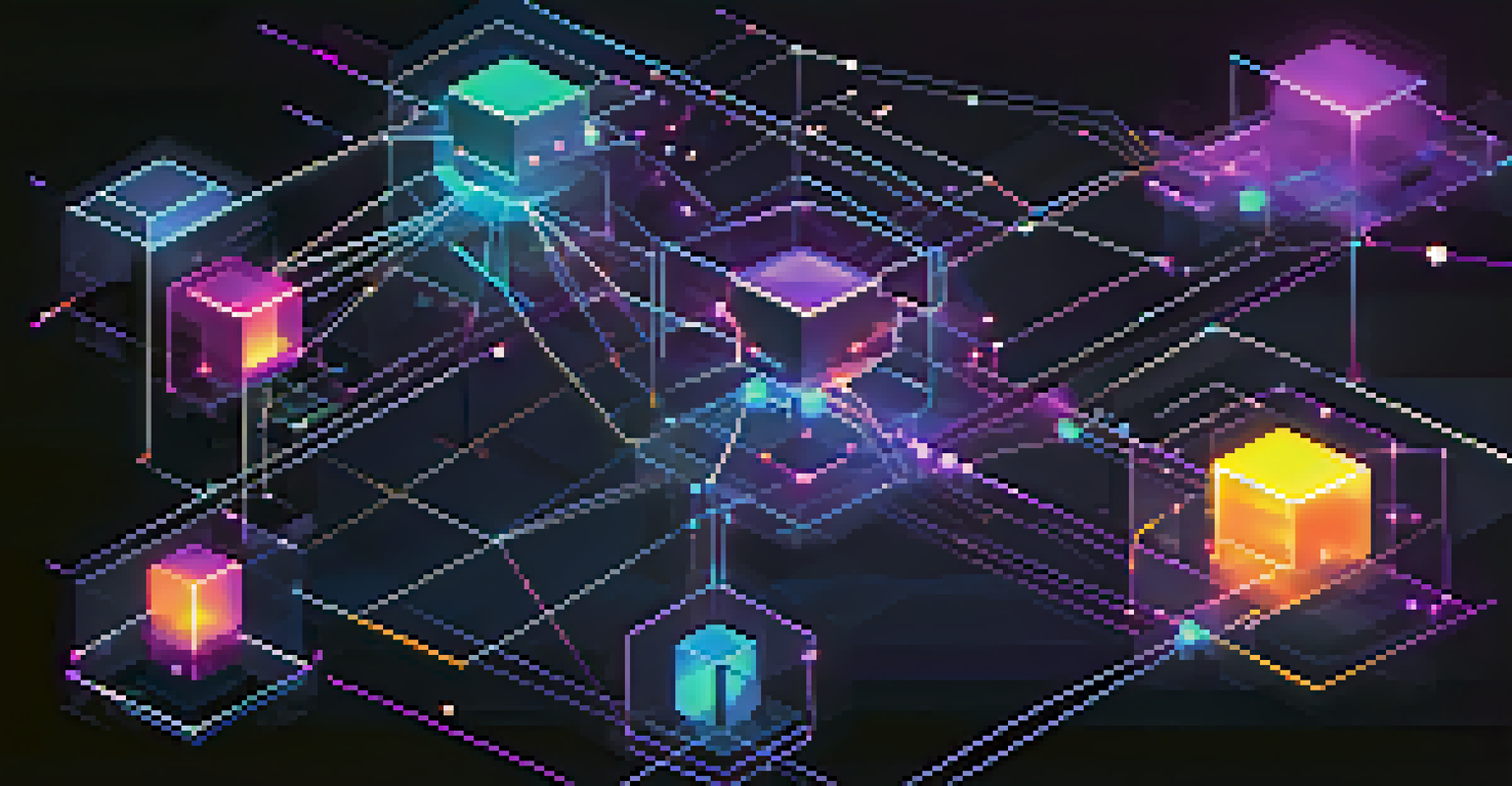Creating Transparent Research Records Using NFTs Technology

Understanding NFTs and Their Role in Research Transparency
Non-Fungible Tokens (NFTs) are unique digital assets that represent ownership or proof of authenticity for a specific item, often stored on a blockchain. This technology can transform the way we record and share research findings, ensuring that each piece of data is verifiable and tamper-proof. In a world where academic integrity is paramount, NFTs offer a solution that enhances trust between researchers, institutions, and the public.
Blockchain technology is an important tool for ensuring transparency and trust in research.
Imagine a scenario where every research paper, dataset, or experiment can be traced back to its original creator without the risk of modification or misrepresentation. This capability not only protects the intellectual property of researchers but also promotes a culture of openness and accountability. By utilizing NFTs, researchers can provide a transparent history of their work, making it easier for others to validate and build upon their findings.
As the academic community adapts to new technologies, the integration of NFTs could become a standard practice. This shift could reshape how research is conducted and shared, paving the way for a more collaborative and transparent future.
The Benefits of Using NFTs for Research Documentation
One of the primary benefits of using NFTs in research documentation is the enhanced security they provide. Since NFTs are recorded on a blockchain, they are immutable, meaning once information is stored, it cannot be changed or deleted. This characteristic is crucial in maintaining the integrity of research records, as it ensures the authenticity of findings and protects against data manipulation.

Additionally, NFTs facilitate easier sharing and access to research data. Researchers can mint NFTs for their publications, datasets, or even methodologies and share them with peers or the public. This accessibility can foster collaboration and innovation, allowing others to build on existing research without the barriers of traditional publishing.
NFTs Enhance Research Transparency
Non-Fungible Tokens (NFTs) provide a secure and verifiable way to document research, promoting trust and authenticity.
Moreover, NFTs can create new revenue streams for researchers. By selling or licensing their NFTs, researchers can monetize their work, gaining financial support for future projects. This model encourages a more sustainable approach to research funding, empowering scholars to focus on their work without financial constraints.
Challenges in Implementing NFTs in Research
Despite the advantages, there are several challenges to implementing NFTs in research. One major hurdle is the relatively steep learning curve associated with blockchain technology. Many researchers may not be familiar with how to create, manage, or sell NFTs, which could hinder widespread adoption and utilization within the academic community.
The future of research depends on our ability to embrace innovative technologies and foster collaboration.
Additionally, the environmental impact of blockchain technology raises concerns. Many NFT platforms rely on energy-intensive processes, which can contribute to carbon emissions. As researchers become increasingly aware of sustainability issues, they may hesitate to adopt technologies that conflict with their values.
Finally, there’s the question of standardization. Without a common framework for creating and managing NFTs related to research, fragmentation could occur, leading to confusion and inefficiencies. Establishing industry standards will be vital to ensure that NFTs serve their intended purpose in enhancing research transparency.
Case Studies: Successful Use of NFTs in Research
Several pioneering projects have successfully integrated NFTs into research practices, serving as models for others in the field. For instance, a recent initiative in digital art research utilized NFTs to authenticate and archive various artworks. By linking each piece to a unique NFT, the researchers ensured that each artwork's provenance was secure, allowing for future studies on authenticity and value.
Another notable case involved a team exploring climate change data. They created NFTs for datasets detailing historical climate patterns, enabling other researchers to access verified data points easily. This approach not only preserved the integrity of the original data but also encouraged collaboration among scientists working towards environmental solutions.
Challenges of NFT Adoption
Despite their benefits, the complexities of blockchain technology and environmental concerns pose challenges for researchers.
These examples illustrate the potential of NFTs to revolutionize research documentation and sharing. As more researchers adopt this technology, we could see a shift towards a more open and reliable academic landscape.
How to Create and Manage NFTs for Research Records
Creating NFTs for research records involves a few key steps. First, researchers must identify the digital assets they wish to tokenize, such as research papers, datasets, or visualizations. Next, they can choose a blockchain platform that supports NFT creation, such as Ethereum or Tezos. Each of these platforms has its own processes, so it’s essential to choose one that aligns with the researcher's goals and technical capacity.
Once a platform is selected, researchers can mint their NFTs by uploading their digital assets and completing the necessary metadata, which includes details like authorship, publication date, and a brief description. This metadata serves as a permanent record on the blockchain, confirming the authenticity and ownership of the work. After minting, researchers can manage their NFTs through their chosen platform, where they can track sales, transfers, and ownership history.
Lastly, it's crucial for researchers to promote their NFTs to reach their intended audience. Sharing information about their NFTs on social media, academic networks, or institutional platforms can increase visibility and encourage collaboration. By actively engaging with others in the field, researchers can maximize the impact of their work in the digital landscape.
Future Trends: NFTs and Research Integrity
As NFTs continue to gain traction, we can expect to see evolving trends in how research integrity is maintained. With an increasing emphasis on transparency, institutions may begin to require researchers to adopt NFTs for their publications and data submissions. This shift could lead to a more standardized approach to research documentation, ultimately enhancing the credibility of academic work.
Furthermore, the integration of NFTs might inspire new forms of peer review and citation practices. Imagine a future where researchers can quickly access the NFT history of a study, including every citation and modification made over time. Such a system could streamline the review process and provide greater insight into the evolution of research findings.
Future of Research with NFTs
The integration of NFTs may lead to standardized research practices, improving integrity and collaboration within academia.
Ultimately, the future of research integrity will likely be shaped by the ongoing collaboration between technology and academia. As researchers embrace NFT technology, we may witness a paradigm shift in how academic knowledge is recorded, shared, and validated, fostering a more trustworthy and transparent research environment.
Conclusion: Embracing NFTs for a Transparent Research Future
In conclusion, the adoption of NFTs for creating transparent research records presents a compelling opportunity to enhance academic integrity. While challenges remain, the benefits of improved security, accessibility, and potential revenue streams cannot be overlooked. As the academic community continues to explore innovative solutions, NFTs offer a promising path towards a future where research is more open and trustworthy.
By embracing this technology, researchers can not only protect their work but also contribute to a culture of collaboration and integrity in academia. As we move forward, it will be essential for institutions, scholars, and technology providers to work together in harnessing the full potential of NFTs.

The journey towards a transparent research future is just beginning, and it is an exciting time for academics to explore how NFTs can reshape their practices. By prioritizing transparency and integrity, we can pave the way for a more reliable and collaborative research landscape.